Taxation Theory, Practice & Law: HI6028 Assignment Solution
VerifiedAdded on 2020/04/01
|10
|1937
|118
Homework Assignment
AI Summary
This assignment solution for HI6028 Taxation Theory, Practice & Law addresses five key questions related to tax assessment. The first question calculates net capital gains or losses from asset sales, referencing Section 108-20 and 108-10 of the ITAA 1997. The second question calculates Fringe Benefit Tax using Taxation Ruling TR 93/6. The third question analyzes the allocation of rental property losses between joint owners, Jack and Jill, referencing Section 51 of the ITAA 1997. The fourth question explores tax avoidance principles, citing IRC v Duke of Westminster (1936) Act AC 1. The fifth question assesses income from the sale of felled timber, referencing Subsection 6 (1) of the Income Tax Assessment 1936. The assignment provides detailed calculations, legal references, and conclusions for each scenario, offering a comprehensive understanding of Australian taxation law.
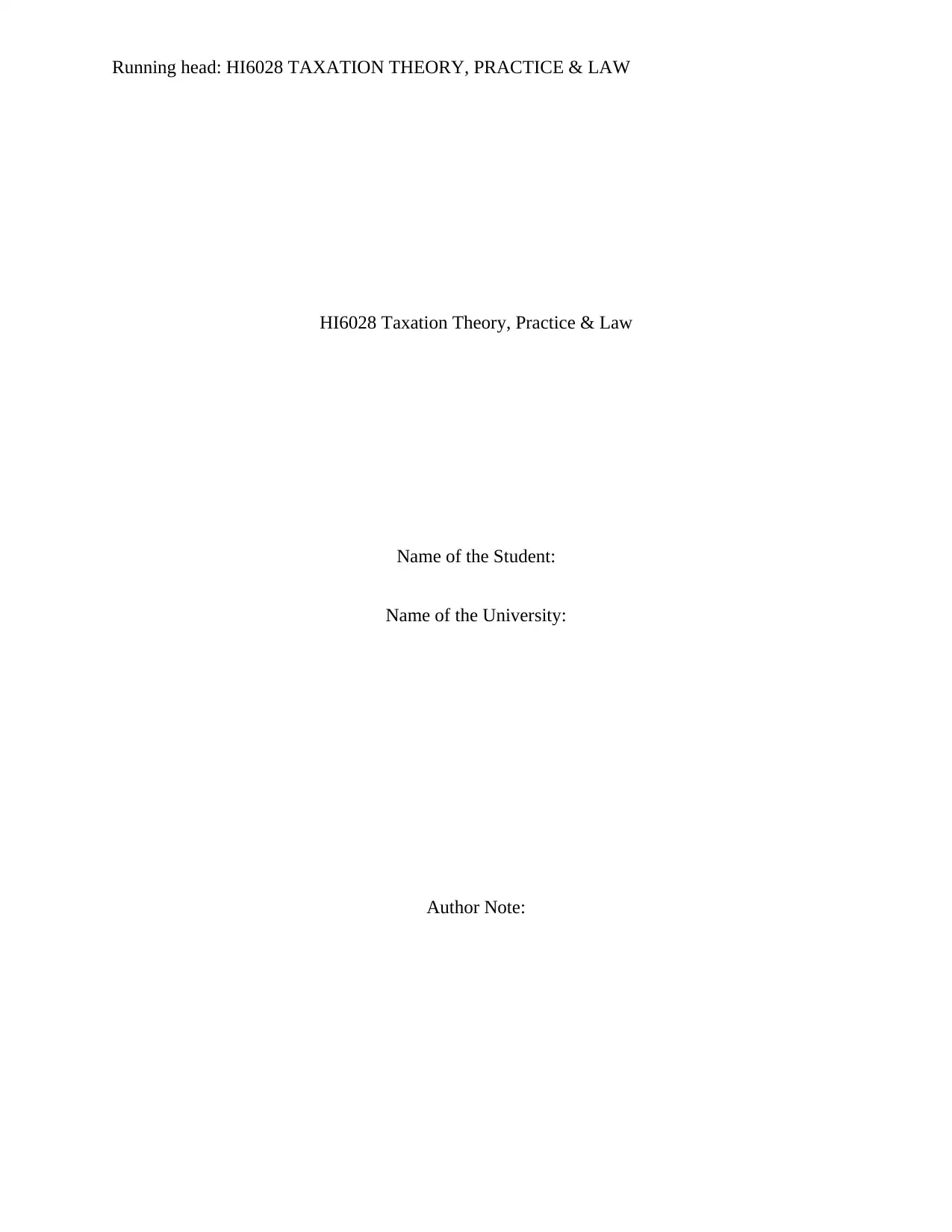
Running head: HI6028 TAXATION THEORY, PRACTICE & LAW
HI6028 Taxation Theory, Practice & Law
Name of the Student:
Name of the University:
Author Note:
HI6028 Taxation Theory, Practice & Law
Name of the Student:
Name of the University:
Author Note:
Paraphrase This Document
Need a fresh take? Get an instant paraphrase of this document with our AI Paraphraser
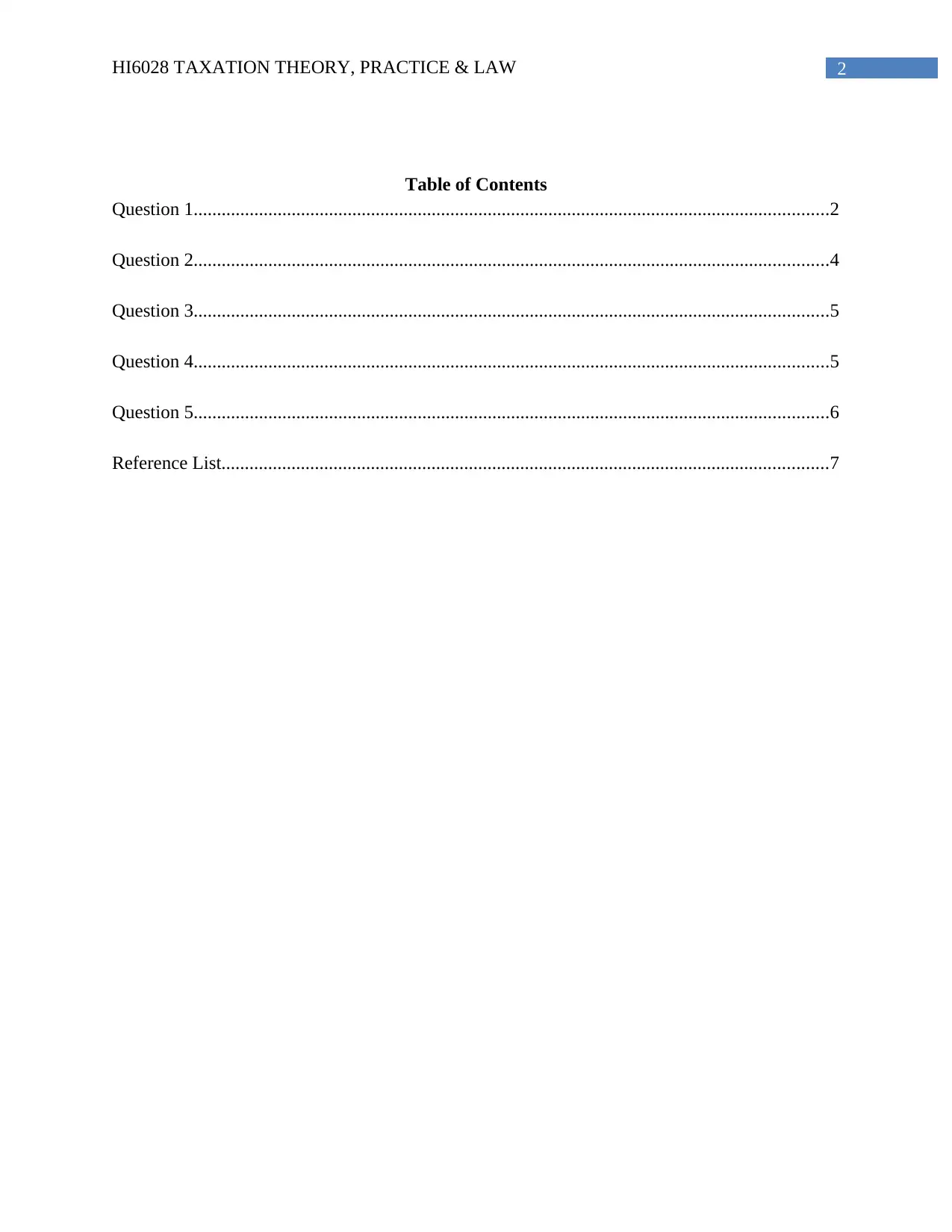
2HI6028 TAXATION THEORY, PRACTICE & LAW
Table of Contents
Question 1........................................................................................................................................2
Question 2........................................................................................................................................4
Question 3........................................................................................................................................5
Question 4........................................................................................................................................5
Question 5........................................................................................................................................6
Reference List..................................................................................................................................7
Table of Contents
Question 1........................................................................................................................................2
Question 2........................................................................................................................................4
Question 3........................................................................................................................................5
Question 4........................................................................................................................................5
Question 5........................................................................................................................................6
Reference List..................................................................................................................................7
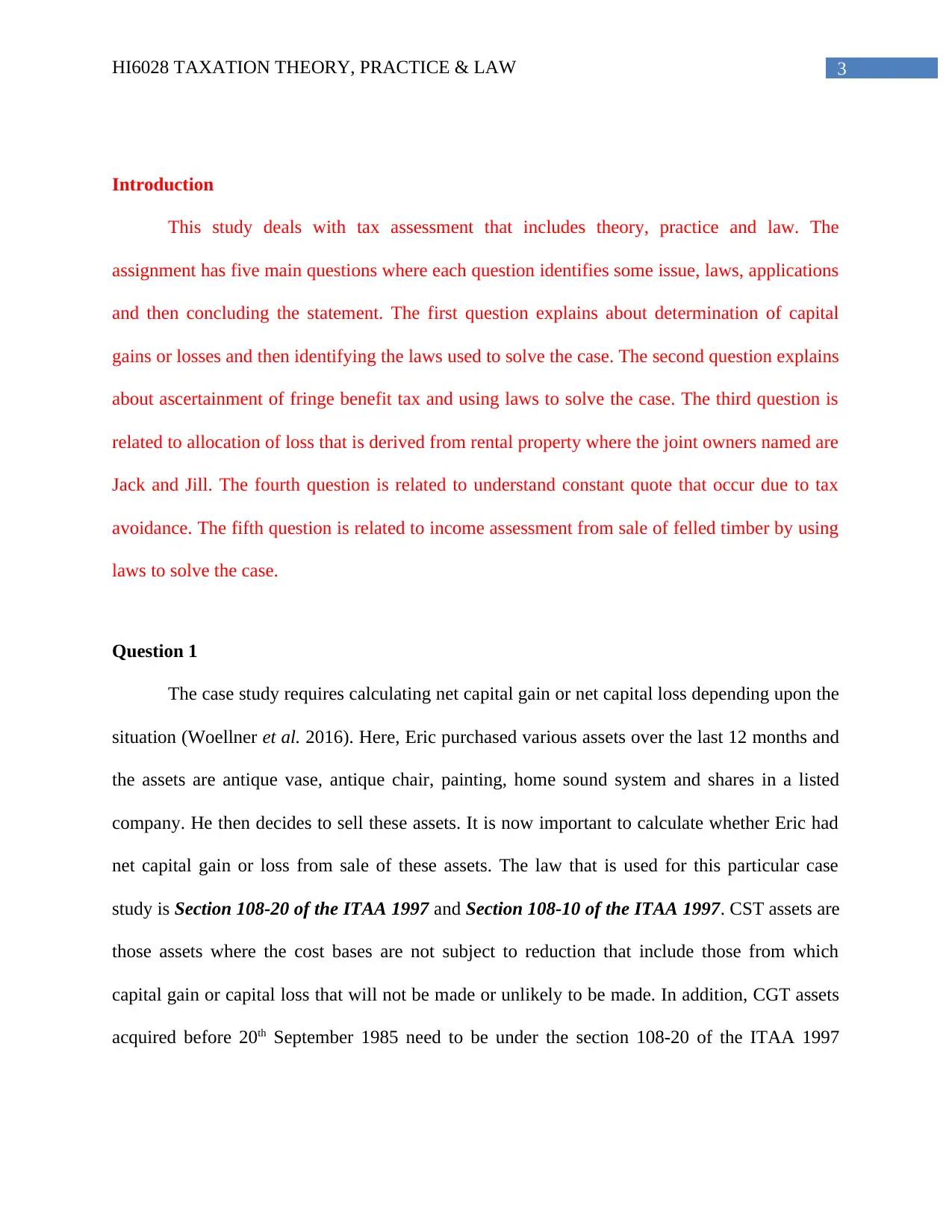
3HI6028 TAXATION THEORY, PRACTICE & LAW
Introduction
This study deals with tax assessment that includes theory, practice and law. The
assignment has five main questions where each question identifies some issue, laws, applications
and then concluding the statement. The first question explains about determination of capital
gains or losses and then identifying the laws used to solve the case. The second question explains
about ascertainment of fringe benefit tax and using laws to solve the case. The third question is
related to allocation of loss that is derived from rental property where the joint owners named are
Jack and Jill. The fourth question is related to understand constant quote that occur due to tax
avoidance. The fifth question is related to income assessment from sale of felled timber by using
laws to solve the case.
Question 1
The case study requires calculating net capital gain or net capital loss depending upon the
situation (Woellner et al. 2016). Here, Eric purchased various assets over the last 12 months and
the assets are antique vase, antique chair, painting, home sound system and shares in a listed
company. He then decides to sell these assets. It is now important to calculate whether Eric had
net capital gain or loss from sale of these assets. The law that is used for this particular case
study is Section 108-20 of the ITAA 1997 and Section 108-10 of the ITAA 1997. CST assets are
those assets where the cost bases are not subject to reduction that include those from which
capital gain or capital loss that will not be made or unlikely to be made. In addition, CGT assets
acquired before 20th September 1985 need to be under the section 108-20 of the ITAA 1997
Introduction
This study deals with tax assessment that includes theory, practice and law. The
assignment has five main questions where each question identifies some issue, laws, applications
and then concluding the statement. The first question explains about determination of capital
gains or losses and then identifying the laws used to solve the case. The second question explains
about ascertainment of fringe benefit tax and using laws to solve the case. The third question is
related to allocation of loss that is derived from rental property where the joint owners named are
Jack and Jill. The fourth question is related to understand constant quote that occur due to tax
avoidance. The fifth question is related to income assessment from sale of felled timber by using
laws to solve the case.
Question 1
The case study requires calculating net capital gain or net capital loss depending upon the
situation (Woellner et al. 2016). Here, Eric purchased various assets over the last 12 months and
the assets are antique vase, antique chair, painting, home sound system and shares in a listed
company. He then decides to sell these assets. It is now important to calculate whether Eric had
net capital gain or loss from sale of these assets. The law that is used for this particular case
study is Section 108-20 of the ITAA 1997 and Section 108-10 of the ITAA 1997. CST assets are
those assets where the cost bases are not subject to reduction that include those from which
capital gain or capital loss that will not be made or unlikely to be made. In addition, CGT assets
acquired before 20th September 1985 need to be under the section 108-20 of the ITAA 1997
⊘ This is a preview!⊘
Do you want full access?
Subscribe today to unlock all pages.

Trusted by 1+ million students worldwide
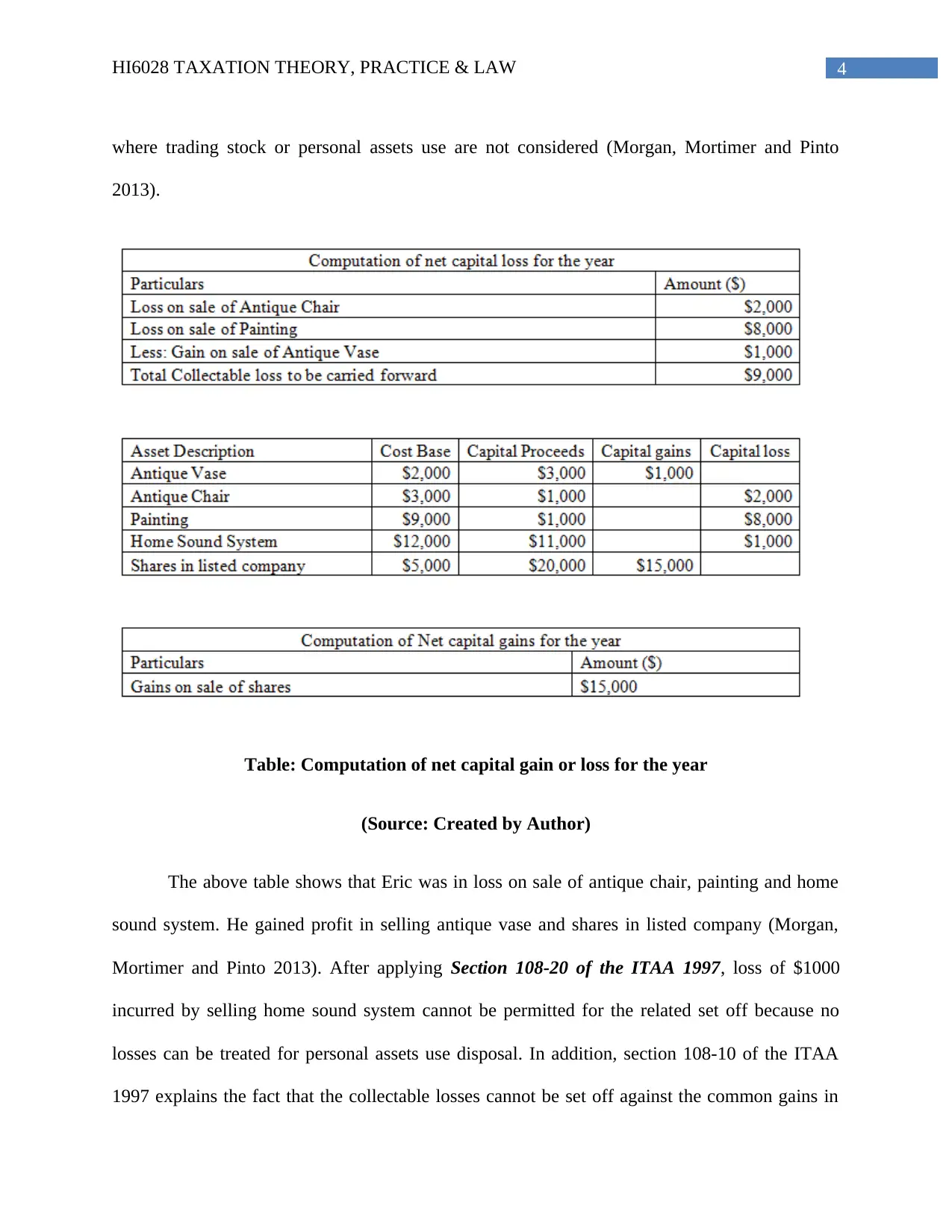
4HI6028 TAXATION THEORY, PRACTICE & LAW
where trading stock or personal assets use are not considered (Morgan, Mortimer and Pinto
2013).
Table: Computation of net capital gain or loss for the year
(Source: Created by Author)
The above table shows that Eric was in loss on sale of antique chair, painting and home
sound system. He gained profit in selling antique vase and shares in listed company (Morgan,
Mortimer and Pinto 2013). After applying Section 108-20 of the ITAA 1997, loss of $1000
incurred by selling home sound system cannot be permitted for the related set off because no
losses can be treated for personal assets use disposal. In addition, section 108-10 of the ITAA
1997 explains the fact that the collectable losses cannot be set off against the common gains in
where trading stock or personal assets use are not considered (Morgan, Mortimer and Pinto
2013).
Table: Computation of net capital gain or loss for the year
(Source: Created by Author)
The above table shows that Eric was in loss on sale of antique chair, painting and home
sound system. He gained profit in selling antique vase and shares in listed company (Morgan,
Mortimer and Pinto 2013). After applying Section 108-20 of the ITAA 1997, loss of $1000
incurred by selling home sound system cannot be permitted for the related set off because no
losses can be treated for personal assets use disposal. In addition, section 108-10 of the ITAA
1997 explains the fact that the collectable losses cannot be set off against the common gains in
Paraphrase This Document
Need a fresh take? Get an instant paraphrase of this document with our AI Paraphraser
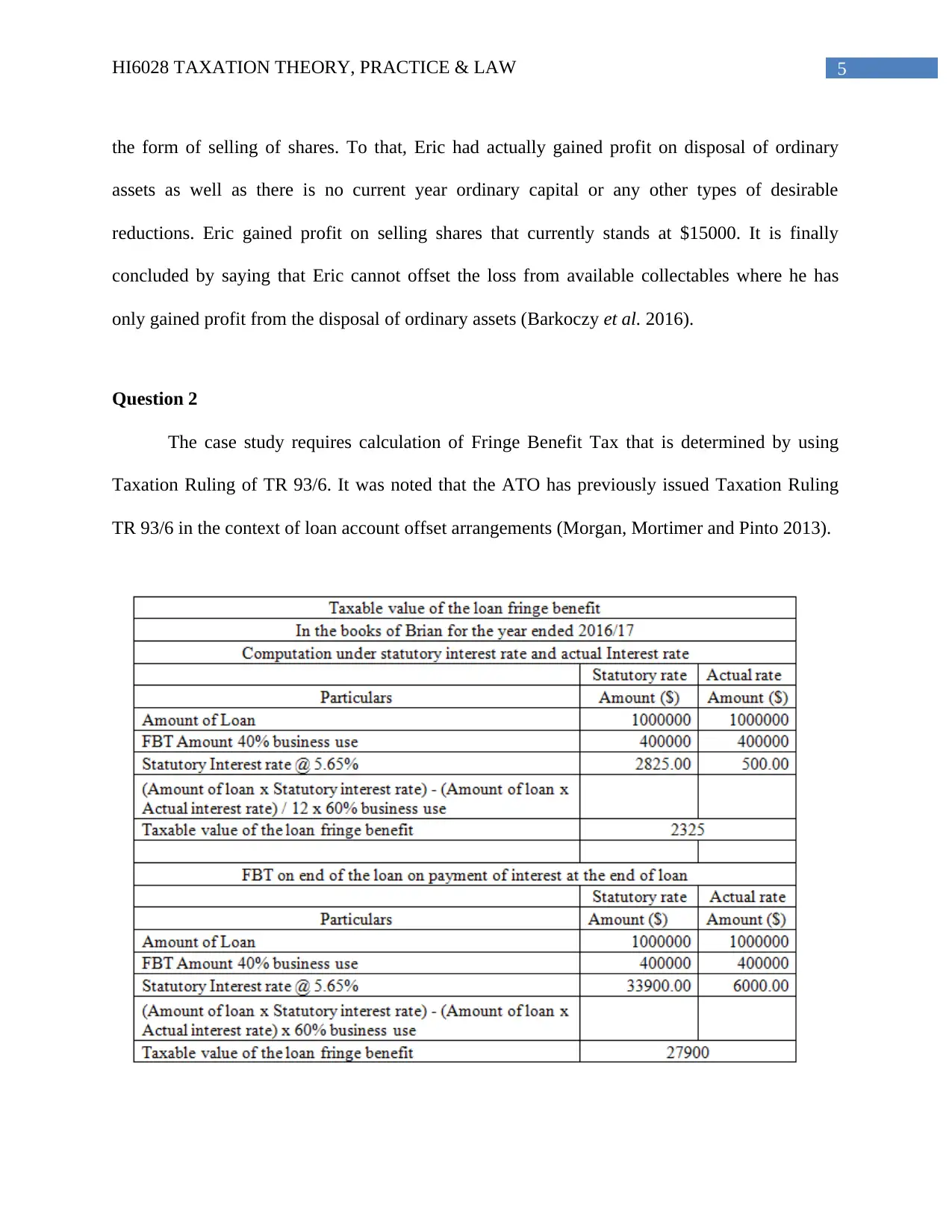
5HI6028 TAXATION THEORY, PRACTICE & LAW
the form of selling of shares. To that, Eric had actually gained profit on disposal of ordinary
assets as well as there is no current year ordinary capital or any other types of desirable
reductions. Eric gained profit on selling shares that currently stands at $15000. It is finally
concluded by saying that Eric cannot offset the loss from available collectables where he has
only gained profit from the disposal of ordinary assets (Barkoczy et al. 2016).
Question 2
The case study requires calculation of Fringe Benefit Tax that is determined by using
Taxation Ruling of TR 93/6. It was noted that the ATO has previously issued Taxation Ruling
TR 93/6 in the context of loan account offset arrangements (Morgan, Mortimer and Pinto 2013).
the form of selling of shares. To that, Eric had actually gained profit on disposal of ordinary
assets as well as there is no current year ordinary capital or any other types of desirable
reductions. Eric gained profit on selling shares that currently stands at $15000. It is finally
concluded by saying that Eric cannot offset the loss from available collectables where he has
only gained profit from the disposal of ordinary assets (Barkoczy et al. 2016).
Question 2
The case study requires calculation of Fringe Benefit Tax that is determined by using
Taxation Ruling of TR 93/6. It was noted that the ATO has previously issued Taxation Ruling
TR 93/6 in the context of loan account offset arrangements (Morgan, Mortimer and Pinto 2013).
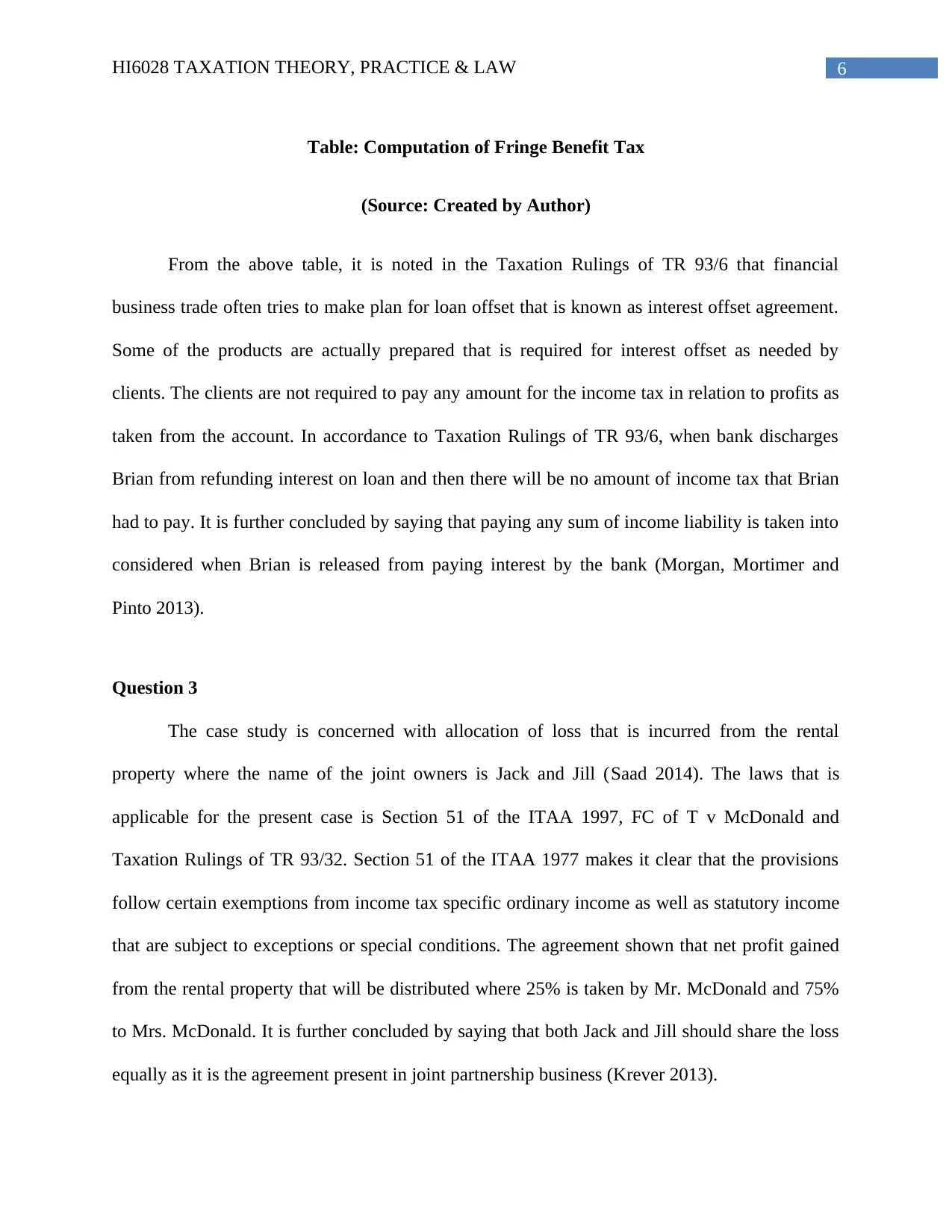
6HI6028 TAXATION THEORY, PRACTICE & LAW
Table: Computation of Fringe Benefit Tax
(Source: Created by Author)
From the above table, it is noted in the Taxation Rulings of TR 93/6 that financial
business trade often tries to make plan for loan offset that is known as interest offset agreement.
Some of the products are actually prepared that is required for interest offset as needed by
clients. The clients are not required to pay any amount for the income tax in relation to profits as
taken from the account. In accordance to Taxation Rulings of TR 93/6, when bank discharges
Brian from refunding interest on loan and then there will be no amount of income tax that Brian
had to pay. It is further concluded by saying that paying any sum of income liability is taken into
considered when Brian is released from paying interest by the bank (Morgan, Mortimer and
Pinto 2013).
Question 3
The case study is concerned with allocation of loss that is incurred from the rental
property where the name of the joint owners is Jack and Jill (Saad 2014). The laws that is
applicable for the present case is Section 51 of the ITAA 1997, FC of T v McDonald and
Taxation Rulings of TR 93/32. Section 51 of the ITAA 1977 makes it clear that the provisions
follow certain exemptions from income tax specific ordinary income as well as statutory income
that are subject to exceptions or special conditions. The agreement shown that net profit gained
from the rental property that will be distributed where 25% is taken by Mr. McDonald and 75%
to Mrs. McDonald. It is further concluded by saying that both Jack and Jill should share the loss
equally as it is the agreement present in joint partnership business (Krever 2013).
Table: Computation of Fringe Benefit Tax
(Source: Created by Author)
From the above table, it is noted in the Taxation Rulings of TR 93/6 that financial
business trade often tries to make plan for loan offset that is known as interest offset agreement.
Some of the products are actually prepared that is required for interest offset as needed by
clients. The clients are not required to pay any amount for the income tax in relation to profits as
taken from the account. In accordance to Taxation Rulings of TR 93/6, when bank discharges
Brian from refunding interest on loan and then there will be no amount of income tax that Brian
had to pay. It is further concluded by saying that paying any sum of income liability is taken into
considered when Brian is released from paying interest by the bank (Morgan, Mortimer and
Pinto 2013).
Question 3
The case study is concerned with allocation of loss that is incurred from the rental
property where the name of the joint owners is Jack and Jill (Saad 2014). The laws that is
applicable for the present case is Section 51 of the ITAA 1997, FC of T v McDonald and
Taxation Rulings of TR 93/32. Section 51 of the ITAA 1977 makes it clear that the provisions
follow certain exemptions from income tax specific ordinary income as well as statutory income
that are subject to exceptions or special conditions. The agreement shown that net profit gained
from the rental property that will be distributed where 25% is taken by Mr. McDonald and 75%
to Mrs. McDonald. It is further concluded by saying that both Jack and Jill should share the loss
equally as it is the agreement present in joint partnership business (Krever 2013).
⊘ This is a preview!⊘
Do you want full access?
Subscribe today to unlock all pages.

Trusted by 1+ million students worldwide
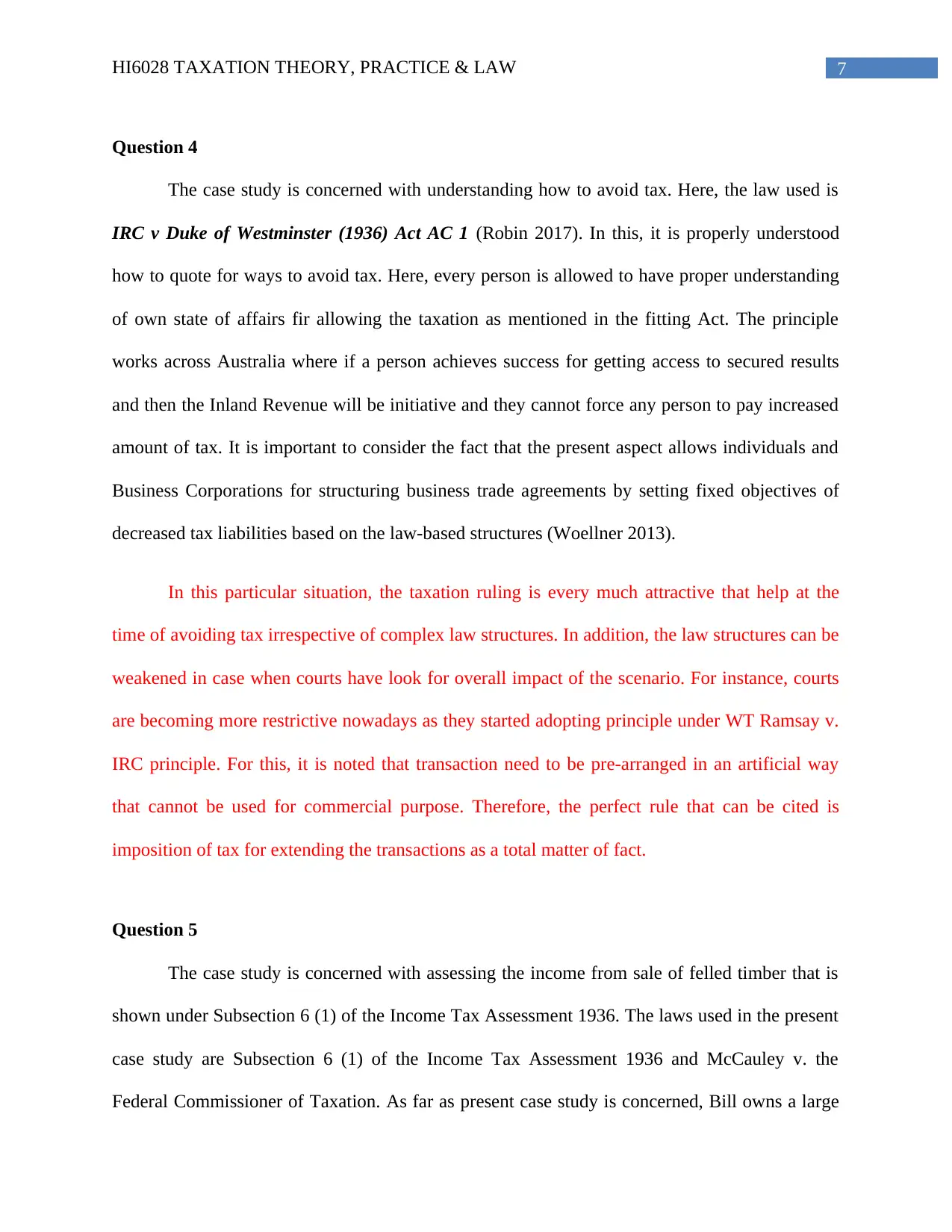
7HI6028 TAXATION THEORY, PRACTICE & LAW
Question 4
The case study is concerned with understanding how to avoid tax. Here, the law used is
IRC v Duke of Westminster (1936) Act AC 1 (Robin 2017). In this, it is properly understood
how to quote for ways to avoid tax. Here, every person is allowed to have proper understanding
of own state of affairs fir allowing the taxation as mentioned in the fitting Act. The principle
works across Australia where if a person achieves success for getting access to secured results
and then the Inland Revenue will be initiative and they cannot force any person to pay increased
amount of tax. It is important to consider the fact that the present aspect allows individuals and
Business Corporations for structuring business trade agreements by setting fixed objectives of
decreased tax liabilities based on the law-based structures (Woellner 2013).
In this particular situation, the taxation ruling is every much attractive that help at the
time of avoiding tax irrespective of complex law structures. In addition, the law structures can be
weakened in case when courts have look for overall impact of the scenario. For instance, courts
are becoming more restrictive nowadays as they started adopting principle under WT Ramsay v.
IRC principle. For this, it is noted that transaction need to be pre-arranged in an artificial way
that cannot be used for commercial purpose. Therefore, the perfect rule that can be cited is
imposition of tax for extending the transactions as a total matter of fact.
Question 5
The case study is concerned with assessing the income from sale of felled timber that is
shown under Subsection 6 (1) of the Income Tax Assessment 1936. The laws used in the present
case study are Subsection 6 (1) of the Income Tax Assessment 1936 and McCauley v. the
Federal Commissioner of Taxation. As far as present case study is concerned, Bill owns a large
Question 4
The case study is concerned with understanding how to avoid tax. Here, the law used is
IRC v Duke of Westminster (1936) Act AC 1 (Robin 2017). In this, it is properly understood
how to quote for ways to avoid tax. Here, every person is allowed to have proper understanding
of own state of affairs fir allowing the taxation as mentioned in the fitting Act. The principle
works across Australia where if a person achieves success for getting access to secured results
and then the Inland Revenue will be initiative and they cannot force any person to pay increased
amount of tax. It is important to consider the fact that the present aspect allows individuals and
Business Corporations for structuring business trade agreements by setting fixed objectives of
decreased tax liabilities based on the law-based structures (Woellner 2013).
In this particular situation, the taxation ruling is every much attractive that help at the
time of avoiding tax irrespective of complex law structures. In addition, the law structures can be
weakened in case when courts have look for overall impact of the scenario. For instance, courts
are becoming more restrictive nowadays as they started adopting principle under WT Ramsay v.
IRC principle. For this, it is noted that transaction need to be pre-arranged in an artificial way
that cannot be used for commercial purpose. Therefore, the perfect rule that can be cited is
imposition of tax for extending the transactions as a total matter of fact.
Question 5
The case study is concerned with assessing the income from sale of felled timber that is
shown under Subsection 6 (1) of the Income Tax Assessment 1936. The laws used in the present
case study are Subsection 6 (1) of the Income Tax Assessment 1936 and McCauley v. the
Federal Commissioner of Taxation. As far as present case study is concerned, Bill owns a large
Paraphrase This Document
Need a fresh take? Get an instant paraphrase of this document with our AI Paraphraser
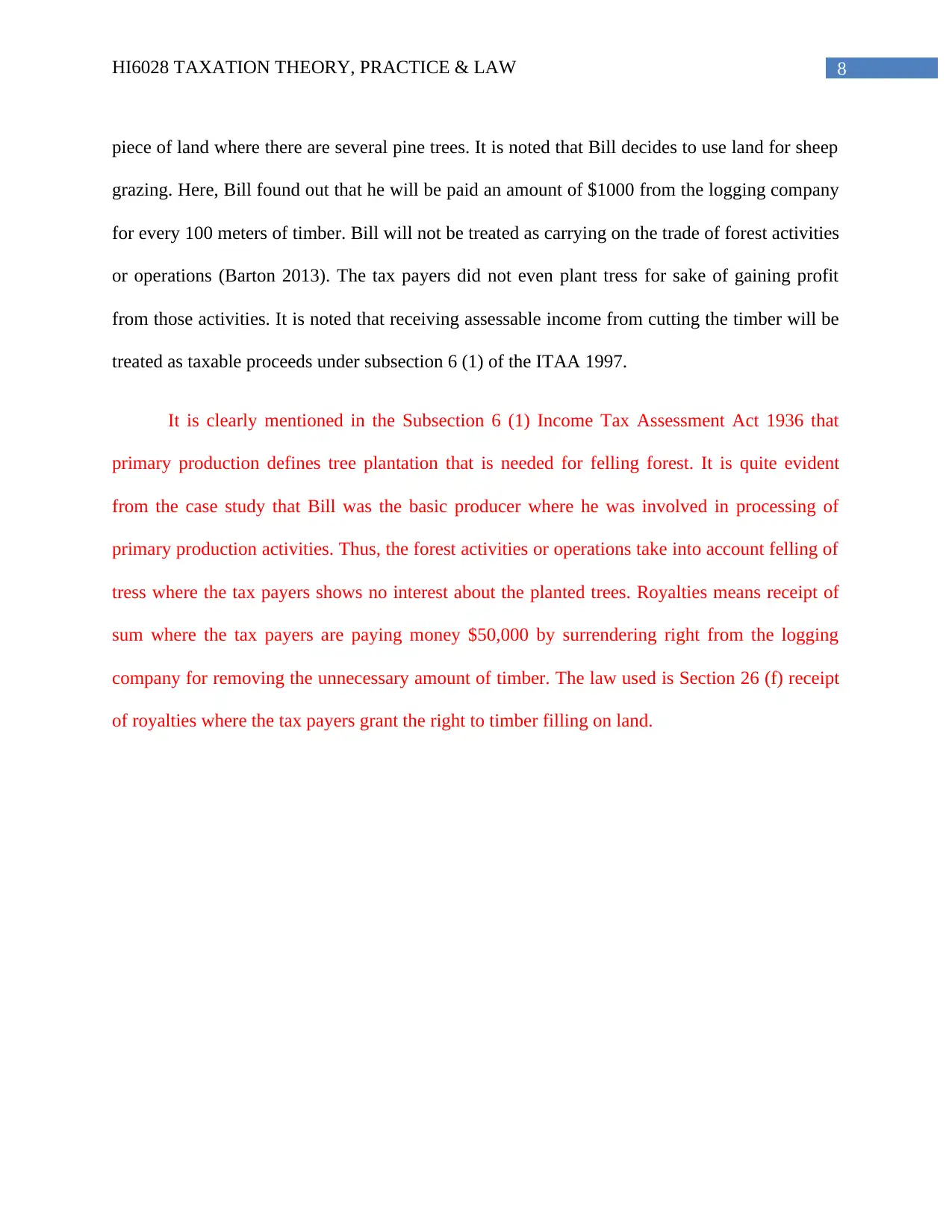
8HI6028 TAXATION THEORY, PRACTICE & LAW
piece of land where there are several pine trees. It is noted that Bill decides to use land for sheep
grazing. Here, Bill found out that he will be paid an amount of $1000 from the logging company
for every 100 meters of timber. Bill will not be treated as carrying on the trade of forest activities
or operations (Barton 2013). The tax payers did not even plant tress for sake of gaining profit
from those activities. It is noted that receiving assessable income from cutting the timber will be
treated as taxable proceeds under subsection 6 (1) of the ITAA 1997.
It is clearly mentioned in the Subsection 6 (1) Income Tax Assessment Act 1936 that
primary production defines tree plantation that is needed for felling forest. It is quite evident
from the case study that Bill was the basic producer where he was involved in processing of
primary production activities. Thus, the forest activities or operations take into account felling of
tress where the tax payers shows no interest about the planted trees. Royalties means receipt of
sum where the tax payers are paying money $50,000 by surrendering right from the logging
company for removing the unnecessary amount of timber. The law used is Section 26 (f) receipt
of royalties where the tax payers grant the right to timber filling on land.
piece of land where there are several pine trees. It is noted that Bill decides to use land for sheep
grazing. Here, Bill found out that he will be paid an amount of $1000 from the logging company
for every 100 meters of timber. Bill will not be treated as carrying on the trade of forest activities
or operations (Barton 2013). The tax payers did not even plant tress for sake of gaining profit
from those activities. It is noted that receiving assessable income from cutting the timber will be
treated as taxable proceeds under subsection 6 (1) of the ITAA 1997.
It is clearly mentioned in the Subsection 6 (1) Income Tax Assessment Act 1936 that
primary production defines tree plantation that is needed for felling forest. It is quite evident
from the case study that Bill was the basic producer where he was involved in processing of
primary production activities. Thus, the forest activities or operations take into account felling of
tress where the tax payers shows no interest about the planted trees. Royalties means receipt of
sum where the tax payers are paying money $50,000 by surrendering right from the logging
company for removing the unnecessary amount of timber. The law used is Section 26 (f) receipt
of royalties where the tax payers grant the right to timber filling on land.
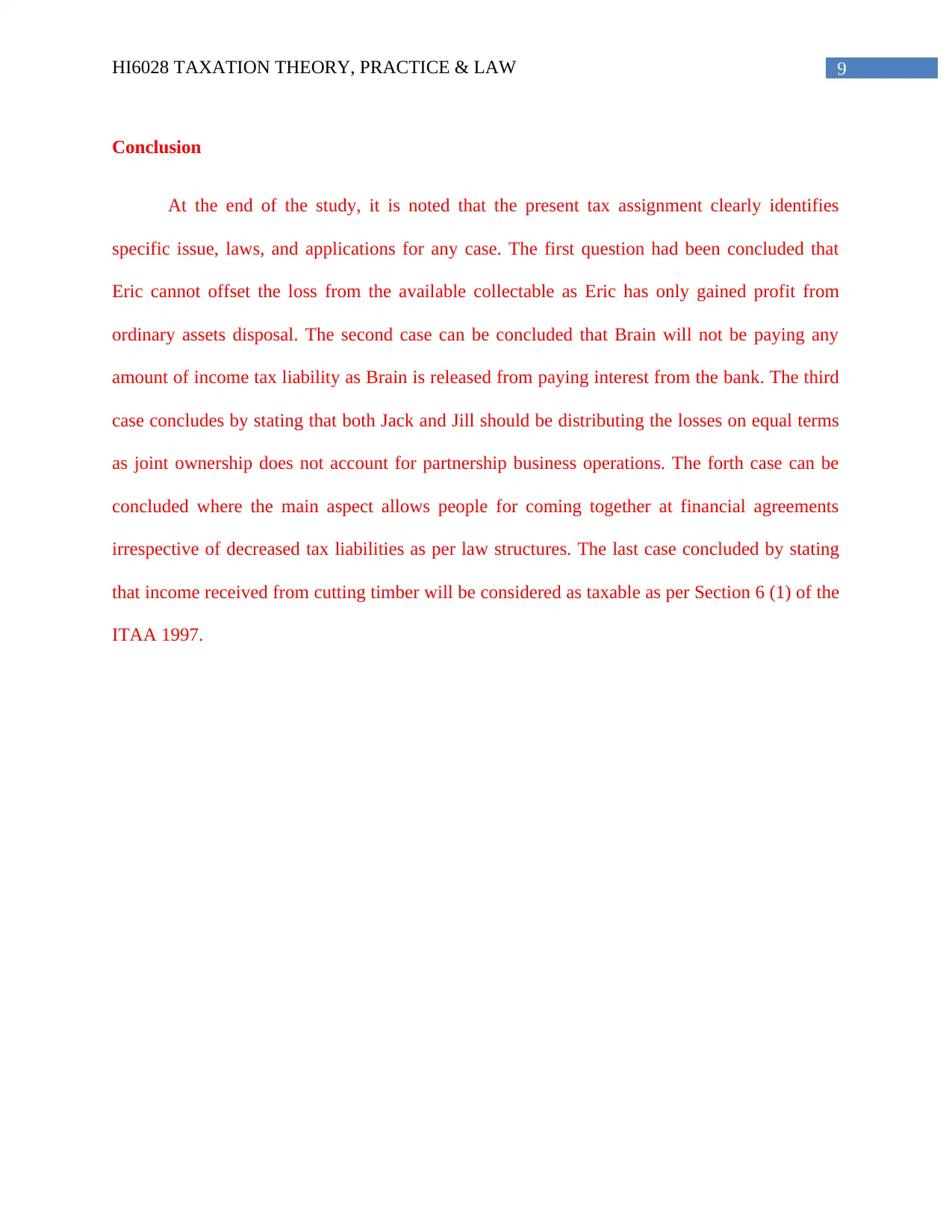
9HI6028 TAXATION THEORY, PRACTICE & LAW
Conclusion
At the end of the study, it is noted that the present tax assignment clearly identifies
specific issue, laws, and applications for any case. The first question had been concluded that
Eric cannot offset the loss from the available collectable as Eric has only gained profit from
ordinary assets disposal. The second case can be concluded that Brain will not be paying any
amount of income tax liability as Brain is released from paying interest from the bank. The third
case concludes by stating that both Jack and Jill should be distributing the losses on equal terms
as joint ownership does not account for partnership business operations. The forth case can be
concluded where the main aspect allows people for coming together at financial agreements
irrespective of decreased tax liabilities as per law structures. The last case concluded by stating
that income received from cutting timber will be considered as taxable as per Section 6 (1) of the
ITAA 1997.
Conclusion
At the end of the study, it is noted that the present tax assignment clearly identifies
specific issue, laws, and applications for any case. The first question had been concluded that
Eric cannot offset the loss from the available collectable as Eric has only gained profit from
ordinary assets disposal. The second case can be concluded that Brain will not be paying any
amount of income tax liability as Brain is released from paying interest from the bank. The third
case concludes by stating that both Jack and Jill should be distributing the losses on equal terms
as joint ownership does not account for partnership business operations. The forth case can be
concluded where the main aspect allows people for coming together at financial agreements
irrespective of decreased tax liabilities as per law structures. The last case concluded by stating
that income received from cutting timber will be considered as taxable as per Section 6 (1) of the
ITAA 1997.
⊘ This is a preview!⊘
Do you want full access?
Subscribe today to unlock all pages.

Trusted by 1+ million students worldwide
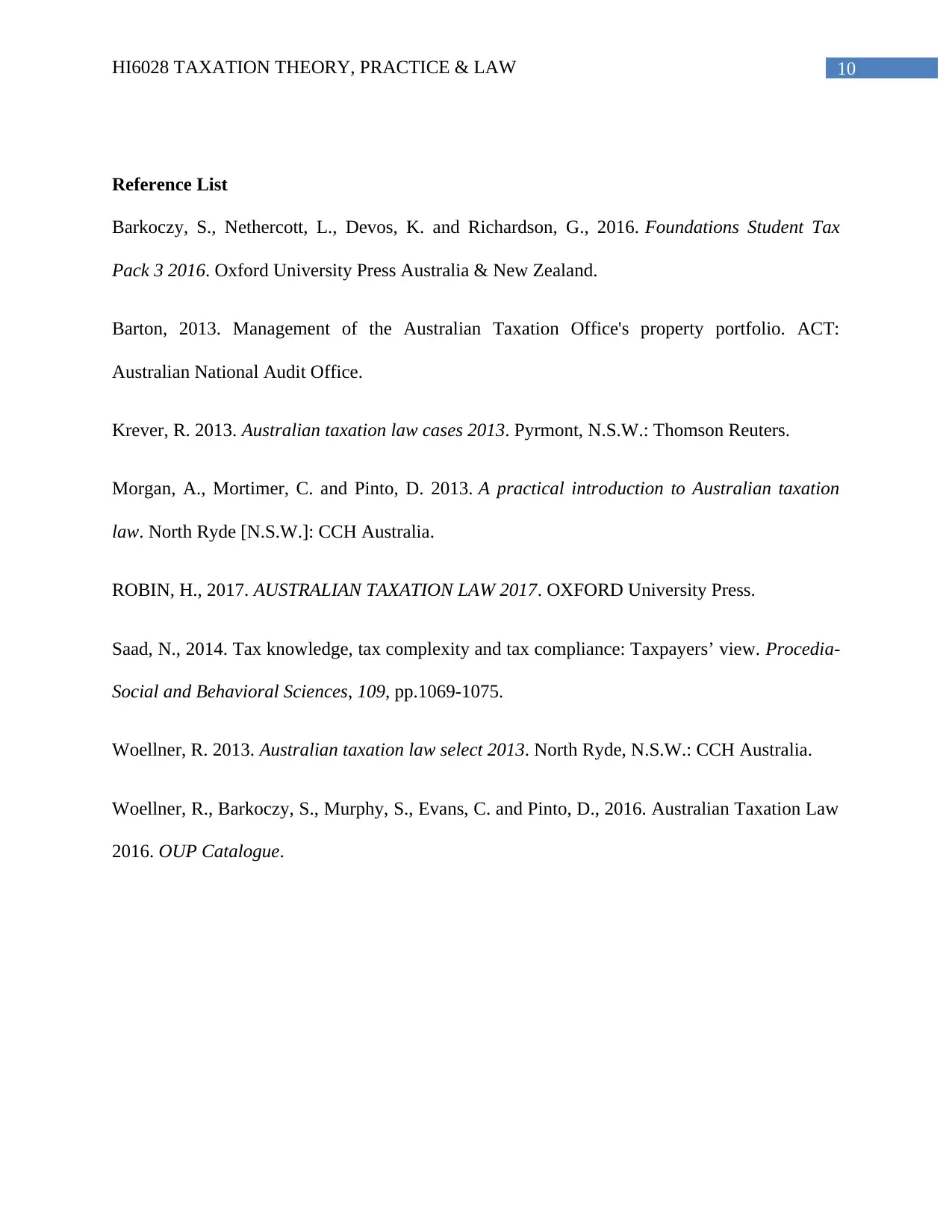
10HI6028 TAXATION THEORY, PRACTICE & LAW
Reference List
Barkoczy, S., Nethercott, L., Devos, K. and Richardson, G., 2016. Foundations Student Tax
Pack 3 2016. Oxford University Press Australia & New Zealand.
Barton, 2013. Management of the Australian Taxation Office's property portfolio. ACT:
Australian National Audit Office.
Krever, R. 2013. Australian taxation law cases 2013. Pyrmont, N.S.W.: Thomson Reuters.
Morgan, A., Mortimer, C. and Pinto, D. 2013. A practical introduction to Australian taxation
law. North Ryde [N.S.W.]: CCH Australia.
ROBIN, H., 2017. AUSTRALIAN TAXATION LAW 2017. OXFORD University Press.
Saad, N., 2014. Tax knowledge, tax complexity and tax compliance: Taxpayers’ view. Procedia-
Social and Behavioral Sciences, 109, pp.1069-1075.
Woellner, R. 2013. Australian taxation law select 2013. North Ryde, N.S.W.: CCH Australia.
Woellner, R., Barkoczy, S., Murphy, S., Evans, C. and Pinto, D., 2016. Australian Taxation Law
2016. OUP Catalogue.
Reference List
Barkoczy, S., Nethercott, L., Devos, K. and Richardson, G., 2016. Foundations Student Tax
Pack 3 2016. Oxford University Press Australia & New Zealand.
Barton, 2013. Management of the Australian Taxation Office's property portfolio. ACT:
Australian National Audit Office.
Krever, R. 2013. Australian taxation law cases 2013. Pyrmont, N.S.W.: Thomson Reuters.
Morgan, A., Mortimer, C. and Pinto, D. 2013. A practical introduction to Australian taxation
law. North Ryde [N.S.W.]: CCH Australia.
ROBIN, H., 2017. AUSTRALIAN TAXATION LAW 2017. OXFORD University Press.
Saad, N., 2014. Tax knowledge, tax complexity and tax compliance: Taxpayers’ view. Procedia-
Social and Behavioral Sciences, 109, pp.1069-1075.
Woellner, R. 2013. Australian taxation law select 2013. North Ryde, N.S.W.: CCH Australia.
Woellner, R., Barkoczy, S., Murphy, S., Evans, C. and Pinto, D., 2016. Australian Taxation Law
2016. OUP Catalogue.
1 out of 10
Related Documents
Your All-in-One AI-Powered Toolkit for Academic Success.
+13062052269
info@desklib.com
Available 24*7 on WhatsApp / Email
![[object Object]](/_next/static/media/star-bottom.7253800d.svg)
Unlock your academic potential
Copyright © 2020–2025 A2Z Services. All Rights Reserved. Developed and managed by ZUCOL.





